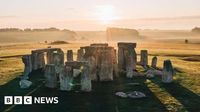On August 21, 2025, a team of British scientists unveiled a fresh chapter in the ever-evolving story of Stonehenge, one of the world’s most enigmatic prehistoric monuments. Their discovery? A Neolithic cow’s tooth, unearthed beside Stonehenge’s south entrance over a century ago, has provided the first direct evidence linking cattle at the site to Wales—the same region where Stonehenge’s famous bluestones originated. This revelation is stirring up new theories about how the monument’s massive stones made their journey from distant quarries to the rolling plains of Wiltshire.
According to the British Geological Survey, Cardiff University, and University College London, the cow’s jawbone, discovered in 1924, was subjected to a meticulous analysis. Scientists sliced the tooth into nine horizontal layers, each representing a sliver of the animal’s life, and examined the isotopes of carbon, oxygen, strontium, and lead. Their goal was to reconstruct the cow’s diet, environment, and seasonal movements. As it turns out, the results were nothing short of remarkable.
"It is another tie between Stonehenge and Wales," said Professor Jane Evans of the British Geological Survey, as reported by BBC News. She explained that the isotopic signatures indicated the animal had grazed on Palaeozoic rock, a geological fingerprint typical of Wales—especially the areas where the bluestones are found. While similar rocks can be found in the Lake District and Scotland, Evans emphasized that the evidence pointed most strongly to Wales. "We're beginning to see so many connections between Wales and Stonehenge. Not only is it the closest rock, but there are other links as well," she added.
The molar itself, about an inch (2.5 centimeters) tall, grew incrementally over six months—from winter to summer during the cow’s second year. This allowed the scientists to track seasonal changes in the animal’s diet and environment. Most intriguingly, the lead isotope composition in the tooth showed spikes during late winter to spring, suggesting the cow originated from an area with much older lead—like the Palaeozoic rocks of Wales—before making its way to Stonehenge. The research team concluded, "The composition suggests the cow originated from an area with Palaeozoic rocks, such as the bluestones found in Wales, before moving to Stonehenge."
This isn’t just another quirky archaeological footnote. The findings reinforce a theory that’s been gaining ground since 2018: cattle, not just humans, played a crucial role in transporting Stonehenge’s stones. For decades, the prevailing image was of Neolithic people dragging these megaliths across the countryside with sheer muscle and determination. But recent studies, including one that found oxen had foot structures typical of animals used for heavy pulling, suggest a new narrative. As Professor Evans put it, "There's been no evidence that cattle were used as beasts of burden in the Neolithic, but that changed in 2018 when there was a paper that showed that oxen had structures in their feet that were typical of animals that were pulling additional weight and working as beasts of burden." She continued, "It feeds into this new narrative that cattle were perhaps important as beasts of burden," noting that cows could also carry lighter kit and supplies.
The significance of the cow’s tooth goes beyond the mechanics of moving stones. The jawbone dates back to Stonehenge’s earliest construction phase, between 2995 and 2900 BC, and was placed in a ritually significant location at the monument’s entrance. This has led researchers to ponder what the animal meant to the people who built Stonehenge. According to The Independent, the unusual lead signal detected in the tooth may be explained by lead stored in the cow’s bones being remobilized during pregnancy—meaning the animal was likely female and either pregnant or nursing at the time. "To me, this was one of the more interesting aspects of the study," Evans remarked. The research invites us to consider the domestic and practical realities of Neolithic life, rather than just the grand ceremonial aspects that usually dominate Stonehenge’s story.
Michael Parker Pearson, professor of British later prehistory at University College London, highlighted the broader implications of the discovery. "This is yet more fascinating evidence for Stonehenge's link with south-west Wales, where its bluestones come from," he told The Independent. The study, he said, raises the "tantalising possibility" that cattle helped to haul the stones—a journey that would have taken two to four months across challenging terrain. Richard Madgwick, professor of archaeological science at Cardiff University, added, "This research has provided key new insights into the biography of this enigmatic cow whose remains were deposited in such an important location at a Stonehenge entrance. It provides unparalleled new detail on the distant origins of the animal and the arduous journey it was brought on."
The logistics of moving the stones—some weighing over 20 tonnes, with the Altar Stone itself transported 750 kilometers from Scotland, according to the Daily Mail—would have required not only brute strength, but careful planning and support. "You've got to have food supplies. A turnover of people and animals to help pulling. You're probably going to have all the domestic requirements of living on the land," Evans told BBC News. The people involved may have been based at Stonehenge for extended periods as the stones were put in place, suggesting a complex and sustained community effort.
One aspect often overlooked in these epic tales of prehistoric engineering is the role of women and children. Evans pointed out, "It's rarely considered that women were involved. Surely they've got to have been there. And probably as many women as men, and children. Making food, providing accommodation, there's a lot involved." The research opens the door to new questions about the wider practicalities and social dynamics of the Neolithic community that built Stonehenge.
The study, titled Sequential multi-isotope sampling through a Bos taurus tooth from Stonehenge, was published earlier this month and represents a significant archaeological breakthrough. As Jane Evans summed up, "A slice of one cow tooth has told us an extraordinary tale and, as new scientific tools emerge, we hope there is still more to learn from her long journey." The research team is now eager to strengthen their conclusions by examining more cattle remains from Stonehenge and its surroundings, hoping to uncover further evidence of ancient long-distance animal movement and the practicalities of monument construction.
Stonehenge, already exceptional for being built entirely of stones sourced from far-flung locations, now stands as a testament not just to the ingenuity of its builders, but also to the vital role of animals—and perhaps the entire community—in one of history’s greatest feats of transportation. With each new discovery, the monument’s story becomes richer, more human, and, if anything, even more fascinating.




